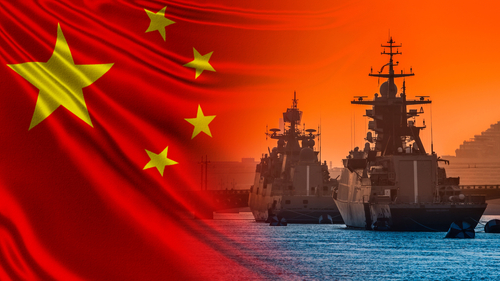
The escalating tensions between the United States and China have taken a new turn with the recent release of footage by China, showcasing what it terms as ‘provocative’ actions by the USS Ralph Johnson in the South China Sea. The incident, which occurred on August 19, has been described by China’s Ministry of National Defense as ‘close-in harassment’ against the People’s Liberation Army Navy (PLAN) task group during their routine training.
The footage reveals the American warship making a sharp turn, crossing the path of the PLAN Guilin, and coming dangerously close within 670 meters of the Chinese vessel. This move by the USS Ralph Johnson is seen by China as a violation of international regulations and agreements between the two nations for the safety of air and maritime encounters.
The Pentagon has released footage of a dangerous approach between a Chinese J-11 fighter jet and an American B-52 strategic bomber over the South China Sea.
The US claims that the distance between the planes at the most critical moment was 3 meters, and doubts that the Chinese… pic.twitter.com/eJ9iYnIO1t
— Sprinter (@Sprinter99800) October 26, 2023
This incident follows the Pentagon’s declassification of 15 videos last Wednesday, showing what they termed as ‘coercive and risky’ behavior by Chinese pilots against US jets. These incidents have been described as ‘risky and coercive’, forcing US pilots to fly through the Chinese jet’s wake turbulence, causing the cockpit to shudder and jolt.
The South China Sea has long been a point of contention between the two superpowers, with China claiming almost all of it. The US and its allies have been conducting military drills in the region, much to China’s displeasure. The recent actions by the USS Ralph Johnson could be seen as a show of strength and a message to China that the US will not back down.
These are all the warships of the Chinese navy. pic.twitter.com/DBLegyvsml
— hello world (@hellowo63335565) October 23, 2023
However, these actions also raise concerns about the potential for escalation and the risk of an unintended conflict. The US must tread carefully to ensure that its actions do not inadvertently lead to a larger conflict. It is crucial to maintain open lines of communication and adhere to international norms and agreements to prevent any misinterpretation of actions.
The recent incident also highlights the growing military capabilities of China. The US Secretary of the Navy, Carlos Del Toro, has raised concerns about China’s naval fleet surpassing America’s in terms of the number of ships and its rapid growth rate. This development underscores the need for the US to reassess its strategy in the region and consider how best to respond to China’s increasing assertiveness.
In conclusion, while it is essential for the US to protect its interests and uphold international norms, it must also be mindful of the potential risks associated with its actions.
A balanced approach that combines strength with diplomacy is needed to manage the complex and evolving dynamics in the South China Sea.











